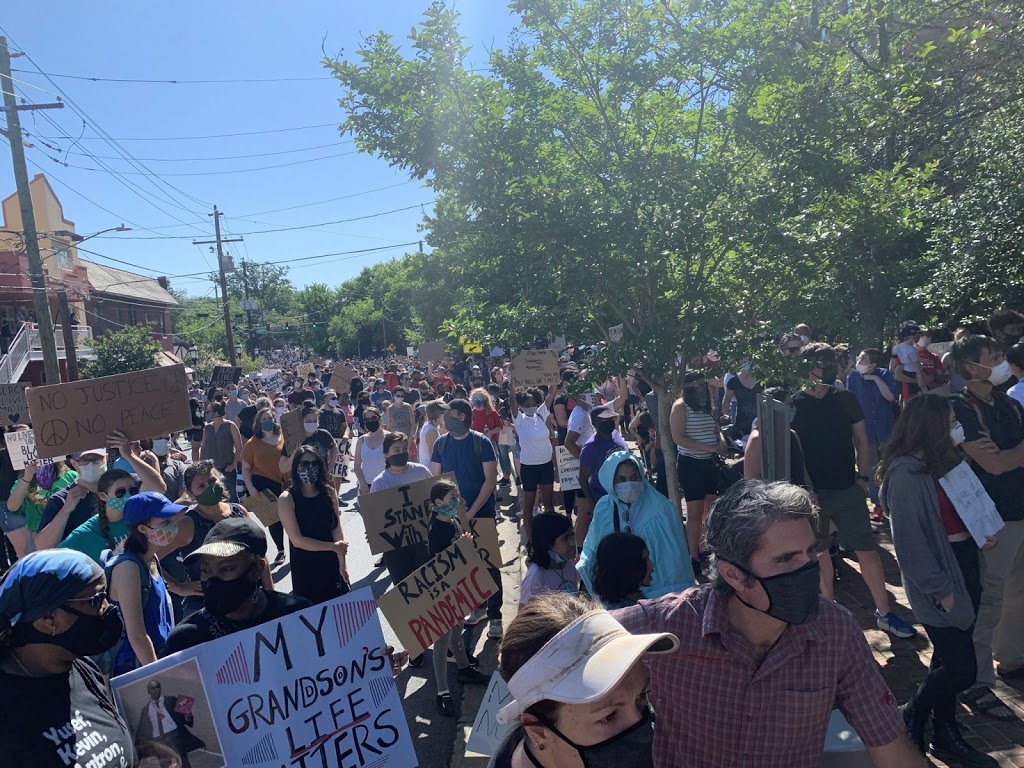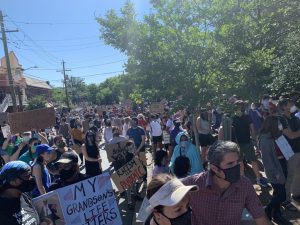
11 Police reform, public safety, and equity ideas for Takoma Park
11 Police Reform Recommendations for a More Just and Equitable Takoma Park
We share a desire to assure public safety, equitably and respectfully, via mechanisms that reflect communal values, redress long-entrenched wrongs, and effectively apply public resources.
The following ideas offer some steps for the City of Takoma Park to address systemic racism, injustices, and inequities that have been part of policing and local government for too long. We offer these humbly, knowing that there are far more ideas for police reform and more equitable government than those we have offered here and look forward to those ideas that come out of community conversations the City has already begun.
The City must invest in a thorough outreach and listening campaign, to reach all the City’s diverse residents in ways that work for them, in places, languages, and with facilitators that make successful interaction possible. That campaign should also include education and ‘teach-ins’ because some of the hardest and most likely areas for reform take time for people new to policing issues to learn about and to understand how options for changes might work.
1. Share more data on use of force and complaints about officers. It’s not enough for annual reports to detail crimes and arrests. The city should also be detailing the number and nature of complaints – especially those involving alleged violation of an individual’s civil rights on file per officer (not identified to person) and strategies taken to resolve complaints. The city should report on and summarize all incidents involving use of force (e.g. handcuffing, unholstering a taser/firearm, pointing a taser/firearm at a person, discharge of a weapon) and proactively make dispatch, body-cam, and other recordings available for public inspection, redacted to conform with general orders and practices. The Council should establish the requirement that all instances that trigger a use of force review by the department, also be reported to the City Council on a monthly basis so that the city’s elected leadership is aware of the level of and trends in use of force by the department. Currently, use-of-force reviews are handled only within the police department. This isn’t good enough. We should also change the definition of use of force to be more expansive. For example, the current definition is triggered when a gun/taser is pointed at a person, but a better standard might be to report on any instances where guns/tasers are unholstered on duty. Another immediate step is to join the Police Data Initiative created by the Obama Administration, as Montgomery County has done but not Takoma Park. To model behavior, that data should also be submitted to the FBI within our required crime reporting.
2. Expand accountability on hiring a police chief. It is time to amend our charter and subject the hiring of a police chief to Council confirmation, revisiting a similar effort that failed in 2011. Having this senior position that supervises one-third of city staff accountable only to our senior bureaucrat and never to elected leaders is inappropriate. Having the Council confirm the city manager’s hire would provide a modest amount of oversight and shared responsibility for the choice. Takoma Park has had experience with a marginally performing police chief hired without council input in the recent past. Having the City Council vote on future hiring of police chiefs will make the department and city stronger.
3. Publish data on the diversity of our police officers and other police department staff and information on recruiting, hiring, and promotion criteria. The public has an interest in knowing the sources the department draws on to recruit officers and staff, the hiring decision criteria applied and their weighting, including how the department evaluates and factors in an experienced candidate’s past misconduct reports, and how promotion decisions are made.
4. Understand internal affairs capacity. It’s unclear from established police policies whether the police department has any sophisticated and independent way to investigate allegations of officer misconduct. Officer-involved shootings and fatalities are referred to the state’s attorney, but what about issues of police corruption, misconduct, or excessive force? The Council should explore how such investigations are handled today and be certain that those practices are effective in building and maintaining the right culture within our police department.
5. Ensure training requirements emphasize restorative justice, bias recognition, and non-violent policing and conflict resolution strategies. Requirements for promotion to senior positions must include extensive and appropriate training in social work, violence prevention, hate crimes, social justice, conflict resolution and other skills that support the guardian model of policing as opposed to the warrior model.
6. Ensure peer intervention policies and practices. Peer intervention and active bystandership training are essential. Think of it as an ‘if you see something, say something’ approach that trains and empowers all officers to intervene when a fellow officer does something wrong. It’s also critical that the city has policies that ensure that police leadership supports and doesn’t punish peer intervention. Our police department needs to adopt and publish policies that make this strategy into a central one that becomes a bedrock in police response to incidents.
7. Examine police department staffing. An examination of crime and staffing data, in light of regional and national trends, and study of Takoma Park service needs will tell us whether we have too many or just the right number of officers and will also reveal unmet community needs. We pay a lot for our police department. Some of that money might be better spent on social programs, or the city might choose to decrease taxes. There is a point at which more guns on police belts do not make us more safe and is disproportionate to the level of need in the community. Crime in Takoma Park is down more than 70% over 15 years, uncorrelated with the size of our police force. This is a strange comparison but for scale, in 2000, we spent roughly $5,400 on policing for every crime that occurred here. In 2018, that number was $17,184 per crime. This is both because crime has consistently gone down and because policing costs have gone up. One specific area that we should consider is whether we truly need a K9 unit in Takoma Park.
8. Consider establishing a resident commission on policing.The City should study the possible establishment of a commission that reports to the Council on policing. The current Police Chief’s Advisory Board is selected by the police chief at his sole discretion and reports only to the police chief, further isolating the department from independent civilian control. Consider creating a committee of residents with a mission to focus on key aspects of policing, just like other committees in the City. One function of this committee could be to serve as a civilian complaint review board with the authority to review case files and bring about actual change. As immediate policing issues and concerns are resolved, the commission’s role could change to one focused more broadly on public safety.
9. Consider hiring social workers. Social workers exist in other police departments as unarmed experts in helping people and communities deal with many of the issues residents have (e.g. Madison, Houston, Portland). Our public safety response does not just have to be composed solely of patrol cars, firearms, tasers, and body armor. Our department can be staffed by people whose training is focused exclusively on social and health issues, crisis intervention training and support, and by staff who are aware of the broad array of state, county, and nonprofit services available to Takoma Park residents. We are uncertain whether social workers would be better placed in the department itself or reporting to the deputy city manager, but integrated into police patrol and dispatch operations. We suggest the Council pick an approach and evaluate how well it works after a few years. The Council should also consider policy language that provides direction on the types of calls to which patrol officers versus other staff respond.
10. Should we have a Public Safety Department? The Council should study whether the city should remake the current police department into an office that has more social workers to focus on food, shelter, drug dependency issues, and conflict resolution; cybercrime response capacity to protect residents from soaring digital and identity crimes; and mental health case workers to focus on the high volume of current police activities that involve individuals with mental illness. It is a big change, so we just recommend studying this idea, but it has potential to completely reframe how to approach public safety.
11. Research what functions could be assumed by the Montgomery County Police Department, moving to a shared-coverage model like Rockville’s and Gaithersburg’s. Rockville and Gaithersburg provide (i.e. pay for) enhanced patrol services beyond what the county covers, but primarily rely on the county police department for patrol services and investigations. Takoma Park also depends on the county for many services. For example, Takoma Park uses the county jail system, which is part of what makes us a sanctuary city (because the county operates under sanctuary policies that govern sharing of information with ICE) and takes part in county-led gang initiatives. The total cost of police in Rockville and Gaithersburg are much lower, per capita, than in Takoma Park, looking at county/state payments and general fund costs for policing combined. Their approach frees up funding to reduce taxes or invest in social programs. In contrast, Takoma Park’s police department makes up almost 30 percent of our budget and pension liabilities from the department are more significant than those from the rest of city staff. The city should commission a study to be completed in 2 years to evaluate whether Rockville and Gaithersburg have equally just, capable, respectful, and community-supported policing services as our city and do so more cost effectively. The study should analyze cost savings that are possible through a bigger county role, and assess Rockville, Gaithersburg, and Takoma Park’s police chiefs’ perspectives on this issue. The principal goal of this recommendation is to understand whether we can maintain or improve our public safety services, while freeing up funding for critical social programs by sharing some or all patrol and investigation services with the county.
 |
| Takoma Park, June 7, 2020. Photo by Alan Zibel. |